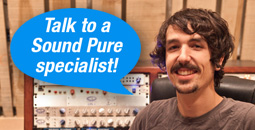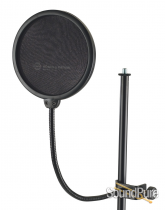-
Call Us Toll Free888-528-9703
-
Local/International (+1)919-682-5552
- Call Us! Toll Free! 888-528-9703
- Local / International (+1) 919-682-5552

Neumann Vintage 1980's U89 Microphone + Shockmount - Used From Neumann
LDC workhorse microphone with 5 directional patterns for increased versatility.
"Gone, Baby, Gone"
This one is sold. Don't miss the next one. Some things never even make it to the site so stay up to date on our used collection.
We get in many oddities, rare and vintage products, most of which go fast. If you're on the hunt for something specific, something unique, or something priced right, let us notify you on our used collection before the items even hit the site.
Want to know if one lands?
Notify MeWant to discuss what's coming?
Manufacturer's Description from Neumann
The U 89 is a studio microphone for universal applications. The headgrille protects a dual-diaphragm capsule. A rotary switch below the headgrille selects from five different polar patterns. Therefore the microphone can be adapted easily to large sound sources, and those that are spread wide apart, or to sound sources to be recorded at a greater distance.
The amplifier accepts sound pressure levels up to 134 dB without distortion. This figure can be increased to 140 dB. An additional rotary switch activates a filter that changes the low frequency response either below 80 Hz or 160 Hz frequency.
Applications
The U 89 is similar in appearance to the U 87. It is of smaller size, and lighter weight. It features five instead of three directional characteristics and a higher maximum sound pressure level which make this microphone easier adaptable to different applications.
Polar patterns
In addition to the usual directional polar patterns: omnidirectional, cardioid, and figure-8, we have added a hypercardioid and wide-angle cardioid characteristic. When compared to the standard cardioid pattern, the hypercardioid characteristic suppresses sound from the side more efficiently. The wide-angle polar pattern is especially useful to record large sound sources.
Acoustic features
The microphone is addressed from the front, marked with the Neumann logo. The large diaphragm capsule has a very smooth frequency response for all polar patterns over a wide acceptance angle. The frequency response curves are flat up to 10 kHz within a pickup angle of ± 100°.
As a result the U 89 i has a very even diffuse-field response for all polar patterns. This is important in a reverberant environment when more reflections arrive at the microphone capsule. The acoustic information is not affected in its tonal quality when recorded by the microphone.
This characteristic is achieved without resorting to corrective resonance effects.
The capsule it is elastically mounted to avoid any structure borne noise that could interfere with its operation.
Filter and attenuation
The amplifier handles sound pressure levels up to 134 dB without distortion. With a self noise level of 17 dB (A-weighted) the total dynamic range is 117 dB. Maximum sound pressure level is 140 dB when the - 6 dB rotary switch is in the ON position.
A low frequency roll-off at 80 Hz or 160 Hz can be activated with another rotary switch below the headgrille. This filter suppresses low frequency interference, yet maintains an even frequency response for close-up sound sources, for example, when proximity effect could adversely affect the program material.
A steep high-pass filter in the LIN position prevents the output transformer of the microphone from being overloaded due to undesired subsonic frequencies.
Operational safety
All exposed surfaces of the microphone capsule, including the diaphragms, are at ground potential. This technology makes them highly immune to electrical and atmospheric interference and contamination through microscopic dust particles.

About Manufacturer
Specializing in some of the finest microphones in the world, Neumann has develpoed a top name in the industry for consistency, reliability, and sonic excellence. With microphones suited for the entire range of studio recording (and more recently live application), Neumann microphones are often a first choice for uncompromised acoustic reproduction.
Specifications
|
Acoustical operating principle |
Pressure gradient transducer |
|
Directional pattern |
Omnidirectional, wide angle, cardioid, hypercardioid, figure-8 |
|
Frequency range |
20 Hz ... 20 kHz |
|
Sensitivity at 1 kHz into 1 kohm |
8 mV/Pa |
|
Rated impedance |
150 ohms |
|
Rated load impedance |
1 kohms |
|
Equivalent noise level, CCIR1) |
28 dB |
|
Equivalent noise level, A-weighted1) |
17 dB-A |
|
Signal-to-noise ratio, CCIR1) (rel. 94 dB SPL) |
66 dB |
|
Signal-to-noise ratio, A-weighted1) (rel. 94 dB SPL) |
77 dB |
|
Maximum SPL for THD 0.5%2) |
134 dB |
|
Maximum SPL for THD 0.5% with preattenuation2) |
140 dB |
|
Maximum output voltage |
800 mV |
|
Dynamic range of the microphone amplifier (A-weighted) |
117 dB |
|
Supply voltage (P48, IEC 61938) |
48 V ± 4 V |
|
Current consumption (P48, IEC 61938) |
0.8 mA |
|
Matching connector |
XLR3F |
|
Weight |
400 g |
|
Diameter |
46 mm |
|
Length |
185 mm |



























